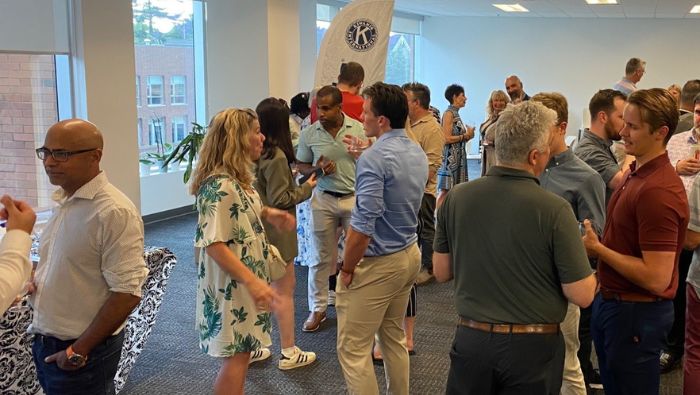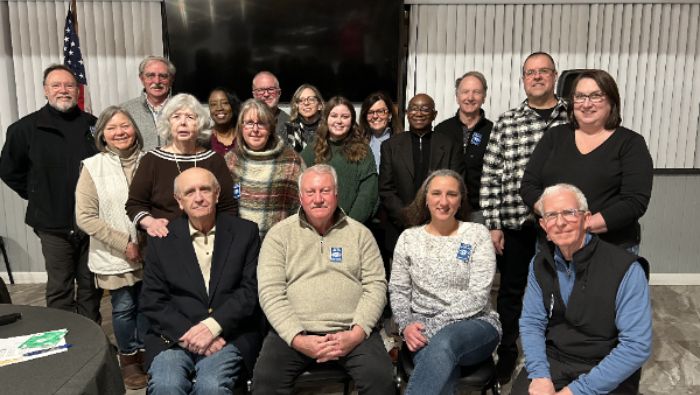
Getting down to the business of membership
A Kiwanis club in Ontario, Canada, has grown by giving young professionals a fun networking opportunity.
By Erin Chandler
When Kiwanis International was founded in 1915, it was an organization to help businessmen make a positive impact in their communities. According to Jarrod Goldsmith, president of the Kiwanis Club of Ottawa, Ontario, Canada, “growing their business and networking” is still one of the top reasons people join Kiwanis.
With that in mind, Goldsmith proposed a new recruitment program for his club in 2023: Kiwanis Socials. From 5-8 p.m. on the third Wednesday of every month, the Ottawa club hosts a social networking event at different locations around the city. The events are open to non-Kiwanians as well as members of Kiwanis clubs throughout the area.
“These are not Kiwanis Club of Ottawa Socials,” he says. “These are Kiwanis socials.”
The only stipulation? The locations must be fun and engaging: a bar, a restaurant, an activity center, etc. Goldsmith encourages clubs to eschew the traditional church basements and find alternative places willing to host an event free of charge.
The goal of Kiwanis Socials is to attract younger members who will keep Kiwanis serving communities well into the future.
“Adapt the organization to where you think the prospective members would be,” Goldsmith advises.
How does it work?
Goldsmith, who has professional experience organizing and hosting events, designed Kiwanis Socials to showcase the fun, vibrant side of Kiwanis — a complement to its ability to form connections and help communities.
The events are free of charge and open to anyone who would like to attend. The typical social draws 30-50 attendees, about half of whom are non-Kiwanis members. There is always food, either provided by the venue or donated by a third-party sponsor.
Goldsmith takes no more than the first 10 minutes to thank the venue and sponsor — giving them a chance to advertise their services — and to talk about the mandate and values of Kiwanis.
“I don’t believe in sales pitches,” he says. “Kiwanis is such an easy sell.”
Goldsmith makes sure to recognize all clubs in attendance. Each club gets a turn at the mic to let everyone know about upcoming events and to ask for extra help if needed. This lets nonmembers see the real work Kiwanis does. Recently, Goldsmith has even spoken to local Rotary clubs about taking part. Other clubs and service organizations aren’t the competition, he says.
“We should be working together to promote the community.”
The rest of the event is for having fun and allowing attendees to network, although there is always the opportunity to bring the conversation back to why Kiwanis matters and the impact it has.
“Networking is what I do,” Goldsmith says. “I like connecting the ecosystem, the community, together.”
Tips for success
For clubs looking to host their own Kiwanis Socials, Goldsmith has some additional advice:
- To organize and lead your socials, look for an active club member who already attends networking events and might have existing relationships in the business community. They can draw on these connections for sponsorships and attendance.
- Plan your events six months in advance and be consistent with dates and times.
- Encourage attendees to engage on social media — take pictures, tag the people and clubs who are there, and use a designated hashtag. This will help increase your club’s social media presence.
- Give door prizes donated by community organizations. Everyone loves a prize — and if you give out tickets for door prizes at the beginning of the night, but award the prizes at the end, it provides an incentive to stay.
- Set up an online RSVP system so that you know approximately how many attendees you will have. If someone shows up without an RSVP, no big deal — just provide forms for them to fill out their contact information.
Think outside the box
When Goldsmith first pitched the idea of Kiwanis Socials, he says some members were skeptical of trying something new, especially an idea from a younger person. But he persisted.
“’We’ve always done it this way’ is the kiss of death [for a club],” he says. “This is thinking differently. And it’s working.”
The Kiwanis Club of Ottawa has gained approximately 25 new members since it began hosting Kiwanis Socials.
“The city of Ottawa is once again talking about Kiwanis, and these Kiwanis Socials are a big reason why our membership is growing,” Goldsmith says. “People are joining our membership because of these events. Because they see the value of intergenerational synergies.”
Above all, Goldsmith encourages Kiwanians to be open to new ideas and perspectives from younger members.
“Let them run with it,” he says. “What have you got to lose? It’s their time on the line. Probably won’t cost anything at all. It doesn’t cost us anything for these Socials. So why not? The worst that can happen is you’ll have a new project.”


